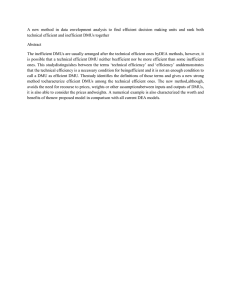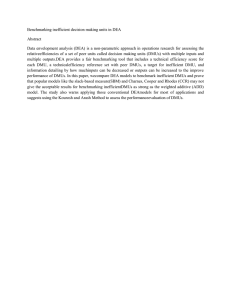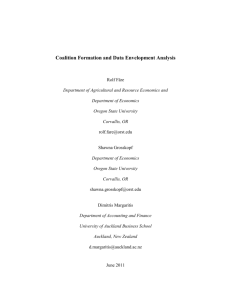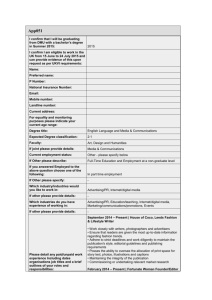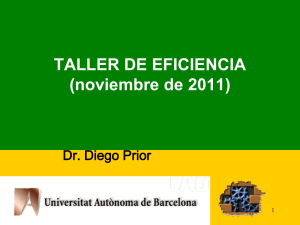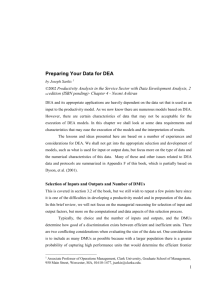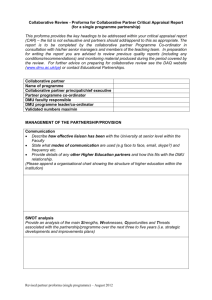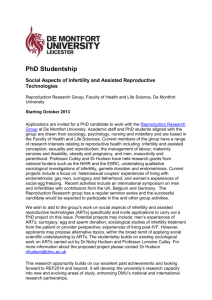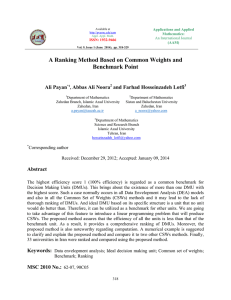A Method for DMUs Classification in DEA
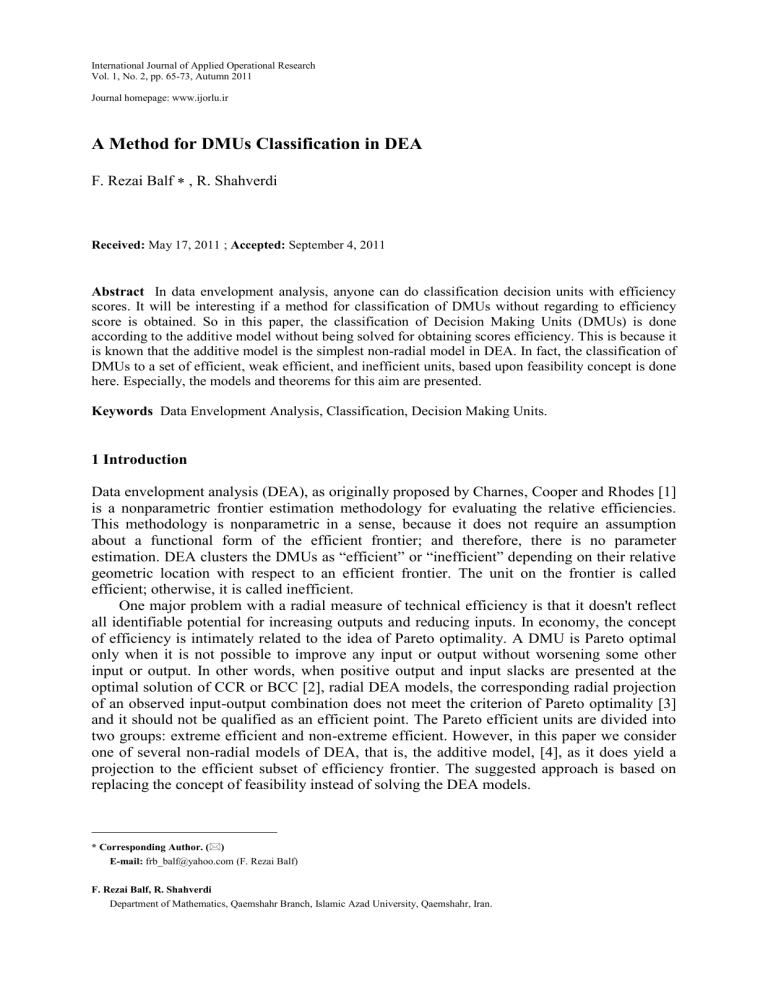
International Journal of Applied Operational Research
Vol. 1, No. 2, pp. 65-73, Autumn 2011
Journal homepage: www.ijorlu.ir
A Method for DMUs Classification in DEA
F. Rezai Balf
, R. Shahverdi
Received: May 17, 2011 ; Accepted: September 4, 2011
Abstract In data envelopment analysis, anyone can do classification decision units with efficiency scores. It will be interesting if a method for classification of DMUs without regarding to efficiency score is obtained. So in this paper, the classification of Decision Making Units (DMUs) is done according to the additive model without being solved for obtaining scores efficiency. This is because it is known that the additive model is the simplest non-radial model in DEA. In fact, the classification of
DMUs to a set of efficient, weak efficient, and inefficient units, based upon feasibility concept is done here. Especially, the models and theorems for this aim are presented.
Keywords Data Envelopment Analysis, Classification, Decision Making Units.
1 Introduction
Data envelopment analysis (DEA), as originally proposed by Charnes, Cooper and Rhodes [1] is a nonparametric frontier estimation methodology for evaluating the relative efficiencies.
This methodology is nonparametric in a sense, because it does not require an assumption about a functional form of the efficient frontier; and therefore, there is no parameter estimation. DEA clusters the DMUs as “efficient” or “inefficient” depending on their relative geometric location with respect to an efficient frontier. The unit on the frontier is called efficient; otherwise, it is called inefficient.
One major problem with a radial measure of technical efficiency is that it doesn't reflect all identifiable potential for increasing outputs and reducing inputs. In economy, the concept of efficiency is intimately related to the idea of Pareto optimality. A DMU is Pareto optimal only when it is not possible to improve any input or output without worsening some other input or output. In other words, when positive output and input slacks are presented at the optimal solution of CCR or BCC [2], radial DEA models, the corresponding radial projection of an observed input-output combination does not meet the criterion of Pareto optimality [3] and it should not be qualified as an efficient point. The Pareto efficient units are divided into two groups: extreme efficient and non-extreme efficient. However, in this paper we consider one of several non-radial models of DEA, that is, the additive model, [4], as it does yield a projection to the efficient subset of efficiency frontier. The suggested approach is based on replacing the concept of feasibility instead of solving the DEA models.
* Corresponding Author. (
)
E-mail: frb_balf@yahoo.com (F. Rezai Balf)
F. Rezai Balf, R. Shahverdi
Department of Mathematics, Qaemshahr Branch, Islamic Azad University, Qaemshahr, Iran.
66 F. Rezai Balf, R. Shahverdi / IJAOR Vol. 1, No. 2, 65-73, Autumn 2011 (Serial #2)
The study is arranged as follows: In section 2 several DEA basic models are given. In section 3 we introduce the additive model based on DEA. In section 4, we are determined to distinguish between the resulting classification of DMUs as efficient, weak efficient and inefficient based upon feasibility. Section 5 illustrates an example and section 6 deals with the conclusion.
2 The DEA basic models
This section presents some basic definitions and concepts readable and useful for other sections. They won't be discussed in details. Suppose that the producer uses the input vector x
R m
to produce the output vector y
R s
; i.e., all data are assumed to be nonnegative, but at least one component of every input and output vector is positive. A pair of such semipositive input x and output y , are called the decision making units. The Production
Possibility Set (PPS) is represented as
T
{( , )
R m s
input x can produceoutput y } .
T
The production possibility set T is generally close and convex. Additional properties set
are given as follows:
1.
The observed DMU belongs to T ; ( ( x j
, y j
)
T , j
1,..., n
2.
If ( , )
T , then ( , )
T , t
3.
For any ( , )
T
0.
, any semi-positive ( , ) with x
x and y
).
y T
Arranging the data set in matrices X
( x j
) , and defined by T c
Y
( y j
) , j
1,...
n , the PPS T can be
T
X
x ,
T
Y
y ,
0} .
Where
R n
is a semi-positive vector. Adding the constraint
T e
1 , with e
(1,1,...,1)
T
, to
T c
is equivalent to omitting the postulate 2, then T v
is defined as follows:
T v
T
X
x ,
T
Y
,
T
1,
0}
T c and T v
are called the production possibility sets of CCR model [1] and BCC model [2] in
DEA to gather with constant return to scale and variable return to scale respectively. To evaluate the efficiency of DMU o
( o
{1,..., }) , the input-oriented model (1) and the outputoriented model (2) are applied.
Min s.t.
T
X
x , o
T
Y
y o
.
,
(1) and
A Method for DMUs Classification in DEA 67
Max
s.t.
T
T
Y
X
x , o
y o
,
.
(2)
The above mentioned models are called envelopment form CCR model if
{
0} and envelopment form BCC model if
{
0, e
T
1} .
3 DEA additive model
Consider the additive model with input-output crisp data. This model was introduced by [3]:
Max w
T e s
_ T e s
s.t. j n
1
x j j
s
x , o j n
1
y j j
s
y o
, s
0, s
0,
.
(3) or equivalently we have:
Max s.t. w
i m
1 s i s r
1 s r
j n
1
x j ij
s i
x io
, i
1,..., m , j n
1
j y rj
s r
y ro
, r
(4) s
, s i r
.
0, i
1,..., m r
s
In the literature of data envelopment analysis different models are proposed to determine efficient units, weak efficient units and inefficient units. Here, we like to take a deeper look at the additive model in order to classify the DMUs with it. The classical DEA models rely on the assumption that inputs have to be minimized and outputs have to be maximized.
Following the efficient subset (ET), weak efficient (WET) and inefficient (INET) of the production possibility set T can be defined respectively as follow:
E T
{( , )
T x
,
y , ( , )
( , )
( , )
T } .
WE T
{( , )
T ( , )
E T , (( x
x , y
y )
( , )
T ) }
INE T
{( , )
T ( x
x , y
y )
( , )
T }
68 F. Rezai Balf, R. Shahverdi / IJAOR Vol. 1, No. 2, 65-73, Autumn 2011 (Serial #2)
To explain the underpinnings of the above definitions, we can use the Fig. 1, which represents the efficient and inefficient Sets, in Farrell model with two inputs and one output. x
2
F
A
B
C
D
E
O x
1
Fig. 1 PPS in Farrell model
In Fig. 1, the symbol O point out (0, 0,1) and the Set { , , , } is called efficient units,
E is weak efficient unit and F is inefficient unit. Therefore, it is obvious that according to the above definitions, the below properties can be resulted.
E T
E T
WE T
WE T
INE T
PPS
INE T
The symbol
is applied for empty set. The above properties express the union and intersection of set efficient, weak efficient and inefficient. The union of them is production possibility set and their intersection is the empty set. In the following sections, we are willing to separate DMUs into three groups, ET , WET , and INET with our focus on the additive model. Thus, one can classify DMUs to measure the efficiency for DMUs. If DMU be a o unit under evaluation by model (4), then it is an efficient unit when w
* unit when w
*
0, for some , i
0 or for some , r
0
0 and weak efficient
, and finally it is an inefficient unit if w
*
0, for all values of i , s i
0 and for all values of , r
0 . It is assumed that the obtained w
* represents the total sum of inefficiencies (total sum of slacks) or DMU [4]. o
4 Classification of DMUs in the additive model
In the earlier part of this paper, we mentioned how to classify DMUs with respect to efficiency score in DEA additive model. It will be interesting if we attain a method for classifying DMUs without regarding to efficiency score. Our focus is based on feasibility additive model. This work is done by revising the additive model. To start, we modify the model (4) as model (5), with replacing s
e
, s
e
, instead of s
0, s
0 . The term
is a non-Archimedean infinitesimal positive number which is smaller than any positive real number.
A Method for DMUs Classification in DEA 69
Max
T e s
_ T e s
s.t. j n
1
x j j
s
x , o j n
1
j y j
s
y o
, s
e ,
.
(5)
Now by replacing s
,
e , with s
, s
, in model (5), and by removing the constant value
( m
s ) of objective function, we obtain the model (6) as follows:
Max
T e s
_ T e s
s.t. j n
1
x j j
s
x o
e , j n
1
j y j
s
y o
e , s
0, s
0,
.
(6)
Using the model (5) or (6), we determine the set of efficient DMUs and also inefficient
DMUs. This subject will relate to Theorem 1.
Theorem 1.
Proof.
Suppose that the model (6) has feasible solution then
Suppose ( s
, s
, ), for
DMU o
be a feasible solution model (6).
INE T .
Then we obtain: j n
1
x j j
s
x o
e and j n
1
y j j
s
y o
e or equivalently, we obtain: j n
1
x j j
( s
e )
x o
and j n
1
y j j
( s
e )
y o
.
Hence, it implies: j n
1
j x ij
x io
, i
1,..., m , and j n
1
j y rj
y ro
, r
In other words, we have:
1,..., s .
(
j n
1
x j j n
,
j
1
y j j
)
(
x , y o o
) , that is, DMU o
INE T , because DMU is dominated by o n
1
x j j n
(
,
) .
1 j j
1
y j j
Corollary 1. Suppose that the model (6) is not feasible then DMU o
E T
WE T .
1 We say DMU p
:( x p
, y p
) dominates DMU q
:( x q
, y q
) if and only if x p
x q and y p
y q and inequality be strict in at least one component.
70 F. Rezai Balf, R. Shahverdi / IJAOR Vol. 1, No. 2, 65-73, Autumn 2011 (Serial #2)
As demonstrated in Theorem 1, we can only distinguish between efficient and inefficient
DMUs, with respect to the feasibility of model (6). Now, we show a model and two theorems for the separation of efficient units of weak efficient units. Considering the following model
(7):
Max w
0 s.t. j n
1
x
x j ij io
, i
1,..., m , r
(7) j n
1
j y rj
y ro
,
.
Theorem 2. Suppose ( x o
, y o
)
T . A unit ( x o
, y o
)
WE T if and only if the model (7) is infeasible.
Proof. Suppose ( x o
, y o
)
T according the weak efficiency definition, it is obvious that there is ( , )
PPS , such that x
j n
1
j x j
, y
j n
1
j y j
and j n
1
j x uj
x uo
, u
{1,..., m }, or j n
1
y j vj
y vo
, v
{1,..., } . It implies that ( , ) is dominated by ( x y . Hence, the model o
, o
)
(7) is infeasible. Conversely, suppose that the model (7) is infeasible, since ( x o
, y o
)
T it means that there is u
{1,..., m }, or v
{1,..., } such that j n
1
x j uj
x uo
, or it implies assertion, that is, ( x o
, y o
)
WE T .
Theorem 3. Suppose ( x o
, y o
)
T j n
1
y j vj
y vo
,
and
. A unit ( x o
, y o
)
E T if and only if model (7) is feasible.
Proof. With contradiction, suppose that the model (7) is not feasible. Then according to
Theorem 2, ( x o
, y o
)
T which is a contract. Also ( x o
, y o
) E T , then with respect to
( x o
, y o
)
T , we find DMU o
WE T , and also according to Theorem 2, the model (7) is infeasible. It is also a contract. The proof is complete.
In order to recognize that DMU o
E T or DMU o
WE T , we apply the model (7) with respect to feasibility concept. So far, the DMUs have been divided in two groups, efficient and weak efficient. Now, for classification of efficient DMUs, at first we present the reference set definition.
Definition 1.
For DMU , its reference set, o
E , is defined by o
E
O
{ j
j
*
0 in some optimal solution of model (3)}
{1,..., } .
All the references of a DMU are efficient units. A o
DMU is dominated by one of them or o their some combination. Therefore, we have several results as follows:
1.
DMU o is inefficient; then it is not a member of reference set E , [5]. o
2.
DMU is extreme efficient, then it is only reference for itself [1]. o
A Method for DMUs Classification in DEA 71
3.
DMU is non-extreme efficient, then there exists at least one member of reference set o
E , except itself. o
Hence, by utilizing the foregoing definition and results, we present the following model for recognization and classification of extreme efficient and non-extreme efficient based on the additive model.
Max w
T e s
_ T e s
s.t. j n
1
x j j
s
x , o j n
1
o
y j j
s
y o
,
0, s
0, s
0,
.
(8)
Theorem 4. Suppose DMU o
E T . The model (8) has feasible solution if and only if
DMU be non-extreme efficient. o
Proof. Suppose DMU o
E T and ( s
(8) so that
o
0 . Then we have
0, s
j n
1
x j j
x , o j n
1
y
y j j o
.
, be a feasible solution of model
(9)
This means that
E o
DMU is non-extreme efficient; because there is at least one other unit in o
, other than itself. Conversely, suppose that DMU o
E T and DMU o be non-extreme efficient, then with respect to its definition, in addition to it, there exists at least one other unit in E . This follows that for o
, the equation (9) holds. Therefore,
o
0 .
Theorem 5. Suppose DMU o
E T . The model (8) has not feasible solution if and only if
DMU o
be extreme efficient.
Proof. By contradiction , suppose that DMU o
E T and the model (8) has feasible solution.
Then by Theorem 4, we obtain
Conversely, if DMU o
E T and
DMU o
as non-extreme efficient and this is a contract.
DMU o
isn’t an extreme efficient, it will be non-extreme efficient. Therefore, according to Theorem 4, the model (8) has a feasible solution, also it is a contract. Thus the proof is complete.
So in this paper, we have used some theorems which helps us to recognize and classify
DMUs based on feasibility concept.
72 F. Rezai Balf, R. Shahverdi / IJAOR Vol. 1, No. 2, 65-73, Autumn 2011 (Serial #2)
5 An example
Consider 10 samples of DMUs with two inputs and two outputs which are shown at Table 1.
Table 1.
The set of units with two inputs and two outputs
DMU
1
2
3
4
5
6
7
8
9
10
Input 1
81
85
56.7
91
216
58
112.2
293.2
186.6
143.4
Input 2
87.6
12.8
55.2
78.8
72
25.6
8.8
52
0.1
105.2
Output 1
5191
3629
3302
3379
5368
1674
2350
6315
2865
7689
Output 2
205
0
0
8
639
0
0
414
0
66
Applying the model (6) to
{
0} with
0.1
, we find that DMUs 1, 2, 5, 8 and 9 are efficient, but the other DMUs are inefficient. In other words, the model (6) is infeasible when we evaluate DMUs 1, 2 , 5, 8 and 9, on the other hand the model (6) be feasible for
DMUs 3, 4, 6, 7, and 10 with optimal objective value 311.27, 2164.44, 1229.05, 948.76 and
509.28, respectively. Therefore, we have:
Efficient DMUs ={DMU , DMU , DMU , DMU , DMU }
1 2 5 8 9
Now, using the model (7), to distinguish the extreme efficient unit of non-extreme efficient unit, we obtain that all DMUs are extreme efficient, because the model (7) is infeasible, when we evaluate every one of them with it.
6 Conclusions
In this paper we introduced some of the models and theorems in order to identify and classify
DMUs regarding to feasibility based upon the DEA revised additive model. At first, we divided DMUs in two bundles of efficient and inefficient, and then the efficient DMUs are classified to two groups; that is, extreme-efficient and non-extreme efficient. In this study, we solved several models to identify and classify DMUs, being worthwhile and significant, when one can only use the feasibility property for models. Finally, we recommended to readers to focus on obtaining and classifying DMUs without solving its corresponding models, for sample refer to [6], such that, the efficient DMUs are ranked in it without solving the model.
References
1.
Charnes, A., Cooper, W. W., Rhodes, E., (1978). Measuring the efficiency of decision making units.
European Journal of Operational Research, 2, 429-444.
2.
Banker, R. D., Charnes, A., Cooper, W. W., (1984). Some models for estimating technical and scale inefficiencies in data envelopment analysis. Management Science, 30(9), 1078-1092.
A Method for DMUs Classification in DEA 73
3.
Charnes, A., Cooper, W. W., Golany, B., Seiford, L., Stutz, J., (1985)b. Foundations of data envelopment analysis for Parato-Koopmans efficient empirical production functions. Journal of Econometrics, 30, 91-
107.
4.
Bardhan, I., Bowlin, W. F., Cooper, W. W., Sueyoshi, T., (1996). Models for efficiency dominance in data envelopment analysis. Part I: Additive models and MED measures. Journal of the operations Research
Society of Japan, 39, 322-332.
5.
Cooper, W. W., Li, S., Seiford, L. M., Tone, K., (1999). Data Envelopment Analysis: A Comprehensive
Text with Models, Applications, References and DEA-Solver Software, Kluwer Academic Publisher,
Norwell, Mass.
6.
Jahanshahloo, G. R., Hosseinzadeh, F., Zhiani Rezai, H., Rezai Balf, F., (2007). Finding strong defining hyperplanes of Production Possibility Set. European Journal of Operational Research, 177(1), 42-54.
